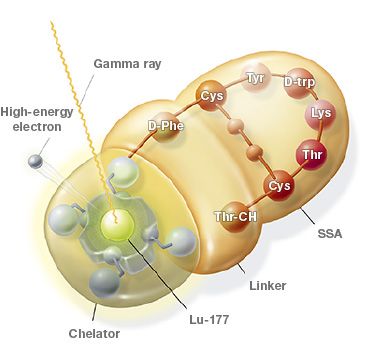Patent Battle Brewing Between Novartis, Lantheus Over Generic Lutathera Radioligand Therapy
The FDA has accepted Lantheus' abbreviated new drug application for a generic Lutathera, just months after Novartis announced positive phase 3 data supporting a first-line indication for the radiopharmaceutical in neuroendocrine tumors.
Lutathera | Image Credit: Novartis

The U.S. FDA has accepted an abbreviated new drug application (ANDA) filed by Lantheus for lutetium lu 177 dototate (177Lu-PNT2003), a generic of Novartis’ Lutathera, a radioligand therapy indicated for the treatment of somatostatin receptor-positive gastroenteropancreatic neuroendocrine tumors in adults.1
Based on characteristics of the filing, Lantheus believes it will be eligible for 180 days of generic marketing exclusivity in the U.S. if the FDA approves the application. Lantheus licensed exclusive worldwide commercialization rights to the generic radiotherapy agent from POINT Biopharma in 2022.
Novartis won original approval of the peptide receptor radionuclide therapy in 2018. The original approval was granted based on data from the pivotal NETTER-1 clinical trial (NCT01578239), which demonstrated that adding lutetium lu 177 dototate to standard of care octreotide LAR resulted in a 79% decrease in risk of disease progression or death in people with inoperable midgut neuroendocrine tumors compared with standard of care alone.
Findings from the phase 3 trial, published in 2017 in the New England Journal of Medicine,2 showed a significant survival benefit in the treatment group, with an estimated rate of progression-free survival at 20 months of 65.2% in the 177Lu-Dotatate group compared with 10.8% in the control group, with a response rate of 18% in the treatment group versus 3% in the control group (P <.001). The interim analysis at the time showed an overall survival benefit, with 14 deaths occurring in the treatment group and 26 in the control group. Myelosuppression was mild and occurred in less than 10% of patients in the treatment group.
Novartis recently read out promising phase 3 data in September 20233 from its NETTER-2 trial (NCT03972488), announcing that Lutathera contributed to a significant improvement in progression-free survival—the trial’s primary end point—compared with standard treatment alone. Novartis is hoping the new data will support a first-line treatment indication for the radiotherapy.
Meanwhile, as part of their commercialization agreement,4 Lantheus and POINT are completing a phase 3 trial (NCT02743741) in Canada evaluating Lutetium-177 Octreotate in 195 patients with somatostatin receptor-positive neuroendocrine tumors. The primary end point is progression-free survival at 12 months from last dose. The trial is ongoing while Lantheus completes regulatory filings in the US.
The news of the application acceptance apparently has Novartis considering its legal options. "We strongly believe in appropriately defending the intellectual property rights and patents of all our products, including Lutathera, because patents allow innovative companies like Novartis to continue to invest in high-risk research to advance breakthrough treatments for patients," a company spokesperson said.
Radioligand therapies are a key focus for growth for Novartis, who recently received FDA approval of a new manufacturing facility for its prostate cancer radiotherapy treatment Pluvicto (lutetium 177 vipivotide tetraxetan). The radiopharmaceutical space in general is seeing a surge of interest from big pharma and investors alike, with a robust early-phase pipeline coming out of small biotech companies that is garnering major attention. POINT Biopharma is one of them, along with entries from Mariana Oncology and RayzeBio, among others, for indications including neuroendocrine gastroenteropancreatic tumors and small cell lung cancer.
REFERENCES
Lantheus Announces Acceptance of its First-to-File ANDA for Generic LUTATHERA® (Lutetium Lu 177 Dotatate). News release. Lantheus Holdings. January 11, 2024. Accessed January 12, 2024. https://www.globenewswire.com/news-release/2024/01/11/2807869/0/en/Lantheus-Announces-Acceptance-of-its-First-to-File-ANDA-for-Generic-LUTATHERA-Lutetium-Lu-177-Dotatate.html
Strosberg J, El-Haddad G, Wolin E, et al. Phase 3 trial of 177 lu-dotatate for midgut neuroendocrine tumors. N Engl J Med. 2017;376(2):125-135. doi: 10.1056/NEJMoa1607427
Novartis radioligand therapy Lutathera® demonstrated statistically significant and clinically meaningful progression-free survival in first line advanced gastroenteropancreatic neuroendocrine tumors (GEP-NETs). News release. Novartis. September 25, 2023. Accessed January 12, 2024. https://www.novartis.com/news/media-releases/novartis-radioligand-therapy-lutathera-demonstrated-statistically-significant-and-clinically-meaningful-progression-free-survival-first-line-advanced-gastroenteropancreatic-neuroendocrine-tumors-gep-nets
Lantheus and POINT Biopharma Announce Strategic Collaboration and Exclusive License Agreements for the Commercialization of PNT2002 & PNT2003. News release. Lantheus Holdings. November 14, 2022. Accessed January 12, 2024. https://www.globenewswire.com/news-release/2022/11/14/2554779/0/en/Lantheus-and-POINT-Biopharma-Announce-Strategic-Collaboration-and-Exclusive-License-Agreements-for-the-Commercialization-of-PNT2002-PNT2003.html
The Reading Room Podcast: Current Perspectives on the Updated Appropriate Use Criteria for Brain PET
March 18th 2025In a new podcast, Satoshi Minoshima, M.D., Ph.D., and James Williams, Ph.D., share their insights on the recently updated appropriate use criteria for amyloid PET and tau PET in patients with mild cognitive impairment.
FDA Grants Fast Track Designation to Emerging Agent for Brain PET Imaging
June 11th 2025Currently being evaluated in a phase 2b clinical trial, the 18F-RAD101 PET imaging agent garnered the FDA’s fast track designation for distinguishing between recurrent disease and treatment impact for brain metastases derived from solid tumors.
New PSMA PET Prep Product Now Available in the U.S.
June 11th 2025Offering an extended shelf life, the FDA-approved Gozellix, a preparation kit for gallium-68 (68Ga) gozetotide injection, is indicated for use in PSMA PET imaging of prostate cancer patients with suspected recurrence or metastasis.